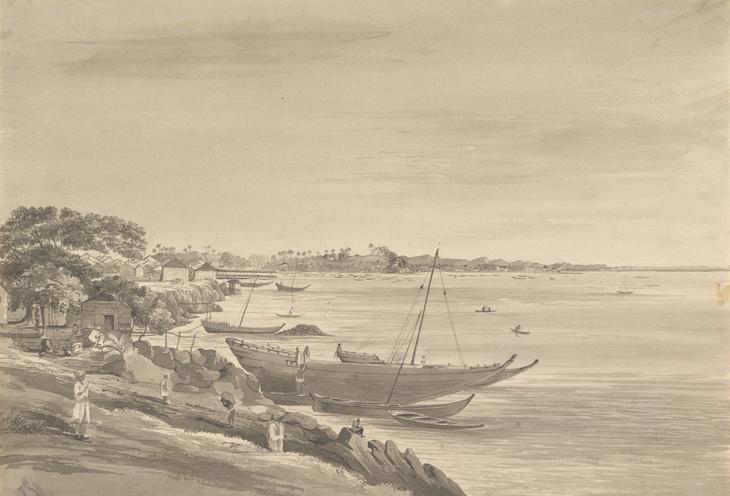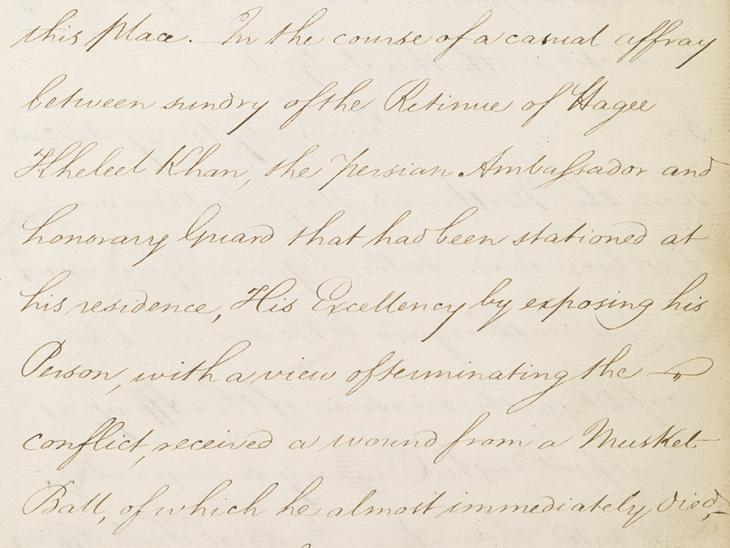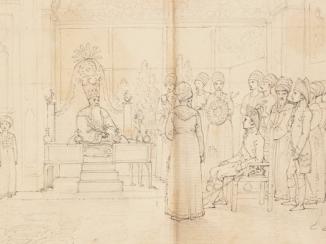Overview
Anglo-Persian Relations in the Late Eighteenth Century
Relations between Persia and Britain intensified during the mid-eighteenth century, due to the increased power of the East India Company (EIC) and its desire both to bolster commerce and to secure the borders of British India. In 1798, Mahdi ‘Ali Khan Bahadur Jang became Britain’s representative in Persia at the court of Fath ‘Ali Shah Qajar. His principal mission was to increase EIC trade by expanding the sales of British woollen goods in Persia. In addition, however, he was also charged with disrupting relations between France and Persia.
In 1800, EIC officer John Malcolm departed on his first mission to Persia. His objective was to solidify the first contact established by Mahdi ‘Ali Khan, and his principal duty was to formalise relations between British India and Qajar Persia. He negotiated two treaties with the Persian court, which focused on consolidating the friendship between Persia and British India. Against the backdrop of war between Britain and Revolutionary France at the time, the treaties not only secured the opening of Persian ports to British trade, but also closed them to French merchants.

A year later, Hajji Khalil Khan Qazvini was nominated as Persian Ambassador to the British Government in India. He was selected in part because of his contacts as a merchant; he already had professional relationships with the EIC Agents in Basra, Samuel Manesty and Harford Jones. One of his first duties was to deliver the Shah’s amendments to Malcolm’s political and commercial treaties, and to reciprocate Malcolm’s visit to the Persian Court during the previous year. His arrival in Bombay [Mumbai] on 21 May 1802 is recorded in the British periodical, The Asiatic Annual Register. The Register describes a voyage of considerable difficulty and danger for the Ambassador and his retinue. Among the difficulties was the loss of ‘a large portion of his property’ when one of the vessels was seriously damaged (IOR/F/4/160/2791, f. 222v). The journey, however, was rewarded with an outstanding welcome. The Register provides lavish details of how the British Government in Bombay greeted Hajji Khalil, in their attempt to demonstrate the importance of the relationship. Crucially, the British Government provided a dedicated guard for the Ambassador, comprising local troops and British officers from the Bengal Establishment. Hajji Khalil himself travelled with a huge entourage of around 120 persons (including relatives, guards, grooms, and servants), in addition to animals and presents.

Death and Disaster in Bombay
However, all these efforts were in vain, as events took a dramatic turn for the worse a month later. On 20 July 1802, a fight broke out between Hajji Khalil’s Persian bodyguards and the guards provided by the EIC at the Ambassador’s Residence. In a letter to the Secret Committee Pre-1784, the Committee responsible for protecting East India Company shipping. Post-1784, its main role was to transmit communications between the Board of Control and the Company's Indian governments on matters requiring secrecy. of the Government of Bombay From c. 1668-1858, the East India Company’s administration in the city of Bombay [Mumbai] and western India. From 1858-1947, a subdivision of the British Raj. It was responsible for British relations with the Gulf and Red Sea regions. , Jonathan Duncan, Governor of Bombay, says that Hajji Khalil intervened and in his attempts to ‘[terminate] the conflict, received a wound from a musket ball, of which he almost immediately died.’ Several other Persians were killed, and others wounded, including Hajji Khalil’s nephew, Agha Husayn.

In The Asiatic Annual Register and other British records, the exact cause of the fight is not mentioned. It seems however that the only victims were Persians, with no injuries reported among the EIC employees. In his celebrated memoirs, the lawyer William Hickey conveys the view held by both British officials and Agha Husayn that it was the Persian guards who initiated the fight. While there are numerous other references to these events in Persian chronicles and ambassadorial reports, there is no other written record in English of precisely what triggered the violence that night.
Damage Control
What is clear is that the Ambassador’s death created great anxiety for British officials. From the first instant, there was panic over what might happen to the recently established cordiality in Anglo-Persian relations, as the Ambassador had been killed while supposedly under the protection of the British Government in India. British officials rushed to investigate what had happened and why. They considered what further steps should be taken both to satisfy the Ambassador’s family and to limit the damage to Britain’s relations with the Persian Court. One of their first actions was to arrest all the EIC guards and the two officers on duty, Lieutenant Fitcher and Captain Routledge, Commander of the Guard. Subsequently, both of the officers and some of the guards involved in the incident were reported to a Court of Enquiry assembled at Bombay, and subject to trial and judicial proceedings. As punishment, Routledge was stripped of his rank and pay for a year, while Fitcher and the other guards were dispatched to the neighbouring island of Salsette.
After a period of mourning and the recovery of the wounded, the Governor-General of India encouraged the majority of the Ambassador’s retinue, including ‘the most respectable men who accompanied it’, to return to Persia, so that ‘they may by their reports remove those sentiments of alarm and horror, which it is to be feared may have been excited’ by the tragic event (IOR/F/4/160/2791, f. 232r). However, the business of Anglo-Persian relations continued, with Agha Husayn staying on in Bombay as the newly acknowledged head of the remaining Persian mission.
Meanwhile, Hajji Khalil’s body was sent to the Shi‘a holy city of Najaf with an annual donation of 10,000 rupees Indian silver coin also widely used in the Persian Gulf. ‘to be distributed for the purposes of devotion and charity at the tomb’ (IOR/F/4/160/2791, f. 246r). In addition, the EIC sought to placate Hajji Khalil’s family and attendants by paying compensation. Recipients included his son and nephew, as well as the families of the other deceased and wounded Persians. The final sum came to 44,800 rupees Indian silver coin also widely used in the Persian Gulf. .
![Excerpt of a letter from the Resident in Bushire [Bushehr] listing Hajji Khalil’s close relatives who were entitled to compensation for his death, 15 February 1803. IOR/G/29/29, f. 26v](https://www.qdl.qa/sites/default/files/styles/standard_content_image/public/ior_g_29_29_0061_crop_web.jpg?itok=n77M0V5V)
In a final measure to ensure the Shah’s understanding, and to preserve the Anglo-Persian alliance, Richard Colley Wellesley, Governor-General of Fort William and Bengal (and older brother of the more famous Arthur Wellesley, Duke of Wellington), wrote a letter of apology reiterating that the sad event was an accident. The letter should have been sent via Jonathan Henry Lovett, the Resident in Bushire [Bushehr], but owing to illness it arrived in Tehran on 2 July 1804 by the hand of Manesty.
Anglo-Persian Relations in the Aftermath
According to British records, the Shah accepted that Hajji Khalil’s death was an accident, and did not hold Britain responsible for the incident. Relieved and satisfied, British officials continued to build relations with Persia. The next Persian Ambassador appointed to British India was Muhammad Nabi Khan Shirazi, Hajji Khalil’s brother-in-law. As well as being a poet and later Vizier of Fars, the new Ambassador’s achievements also included surviving much longer than his predecessor.



